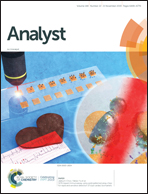Establishment of an immunofiltration strip for the detection of 17β-estradiol based on the photothermal effect of black phosphorescence†
Abstract
Recently, the photothermal effect of nanomaterials has opened the door for new appealing strategy, which can generate a promising and powerful tool when combined with immunoassay. As a new kind of nanomaterial, black phosphorus (BP) has aroused widespread interest. In this study, a novel immunofiltration strip method with temperature as the readout signal based on the photothermal effect of BP nanosheets was established. The temperature was monitored by a portable temperature sensor. Using an indirect competitive strategy, it provides a simple, rapid, sensitive, and economic platform for the detection of 17β-estradiol, a kind of endocrine disrupting compound that is frequently detected in environmental water or food samples. The higher the concentration of 17β-estradiol in the sample, the less BP nanosheets are brought to bind to the strip surface, along with lower temperature variation when exposed to intensive laser irradiation. Under optimum conditions, a detection limit of 0.104 ng mL−1 was achieved. The feasibility of this assay was assessed by a standard addition method in water and milk samples, showing good performance and indicating potential application value for easy-to-use, inexpensive, and on-site monitoring of 17β-estradiol.



 Please wait while we load your content...
Please wait while we load your content...